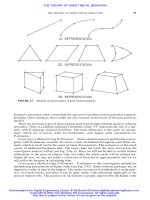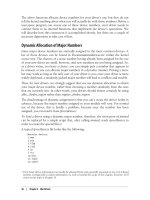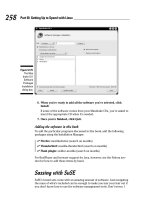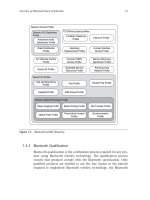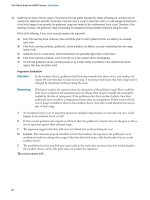matlab primer 6th edition phần 2 pptx
Bạn đang xem bản rút gọn của tài liệu. Xem và tải ngay bản đầy đủ của tài liệu tại đây (78.69 KB, 17 trang )
$ $
You can change & to reflect this change in $ by retyping
the lengthy command
& … above, but it is easier to hit
the up arrow key until you see the command you want,
and then hit enter.
You can clear the Command window with the
FOF
command or with
(GLW &OHDU &RPPDQGZLQGRZ.
Although all numeric computations in MATLAB are
performed with about 16 decimal digits of precision, the
format of the displayed output can be controlled by the
following commands:
IRUPDWVKRUW fixed point, 5 digits
IRUPDWORQJ fixed point, 15 digits
IRUPDWVKRUWH scientific notation, 5 digits
IRUPDWORQJH scientific notation, 15 digits
IRUPDWVKRUWJ fixed or floating-point, 5 digits
IRUPDWORQJJ fixed or floating-point, 15 digits
IRUPDWKH[ hexadecimal format
IRUPDW +, -, and blank
IRUPDWEDQN dollars and cents
IRUPDWUDW approximate ratio of small
integers
IRUPDW VKRUW is the default. Once invoked, the chosen
format remains in effect until changed. These commands
only modify the display, not the precision of the number.
The command
IRUPDW FRPSDFW suppresses most blank
lines, allowing more information to be placed on the
screen or page. The command
IRUPDW ORRVH returns to
© 2002 by CRC Press LLC
the non-compact format. These two commands are
independent of the other format commands.
You can pause the output in the Command window with
the
PRUH RQ command. Type PRUH RII to turn this
feature off.
2.4 Workspace window
This lists variables that you have either entered or
computed in your MATLAB session.
There are many fundamental data types (or classes) in
MATLAB, each one a multidimensional array. The
classes that we will concern ourselves with most are
rectangular numerical arrays with possibly complex
entries, and possibly sparse. An array of this type is
called a matrix. A matrix with only one row or one
column is called a vector (row vectors and column
vectors behave differently; they are more than mere one-
dimensional arrays). A 1–by–1 matrix is called a scalar.
Arrays can be introduced into MATLAB in several
different ways. They can be entered as an explicit list of
elements (as you did for matrix
$), generated by
statements and functions (as you did for matrix
&),
created in a file with your favorite text editor, or loaded
from external data files or applications (see
+HOS:
0$7/$%: *HWWLQJ 6WDUWHG: 0DQLSXODWLQJ
0DWULFHV). You can also write your own functions (M-
files, or mexFunctions in C, FORTRAN, or Java) that
create and operate on matrices. All the matrices and other
variables that you create, except those internal to M-files
(see Chapter 7), are shown in your Workspace window.
© 2002 by CRC Press LLC
The command ZKR (or ZKRV) lists the variables currently
in the workspace. Try typing
ZKRV; you should see a list
of variables including
$ and &, with their type and size. A
variable or function can be cleared from the workspace
with the command
FOHDU YDULDEOHQDPH or by right-
clicking the variable in the Workspace editor and
selecting
'HOHWH 6HOHFWLRQ. The command FOHDU
alone clears all non-permanent variables.
When you log out or exit MATLAB, all variables are lost.
However, invoking the command
VDYH before exiting
causes all variables to be written to a machine-readable
file named
PDWODEPDW. When you later reenter
MATLAB, the command
ORDG will restore the
workspace to its former state. Commands
VDYH and
ORDG take file names and variable names as optional
arguments (type
KHOS VDYH and KHOS ORDG). Try typing
the commands
VDYH, FOHDU, and then ORDG, and watch
what happens after each command.
2.5 Command History window
This window lists the commands typed in so far. You can
re-execute a command from this window by double-
clicking or dragging the command into the Command
window. Try double-clicking on the command:
$ $
shown in your Command History window. For more
options, right-click on a line of the Command window.
2.6 Array Editor window
Once an array exists, it can be modified with the Array
Editor, which acts like a spreadsheet for matrices. Go to
© 2002 by CRC Press LLC
the Workspace window and double-click on the matrix &.
Click on an entry in
& and change it, and try changing the
size of
&. Go back to the Command window and type:
&
and you will see your new array &. You can also edit the
matrix
& by typing the command RSHQYDU&.
2.7 Current Directory window
Your current directory is where MATLAB looks for your
M-files (see Chapter 10), and for workspace (
PDW) files
that you
ORDG and VDYH. You can also load and save
matrices as ASCII files and edit them with your favorite
text editor. The file should consist of a rectangular array
of just the numeric matrix entries. Use a text editor to
create a file in your current directory called
P\PDWUL[W[W that contains these 2 lines:
Type the command ORDG P\PDWUL[W[W, and the file
will be loaded from the current directory to the variable
P\PDWUL[. The file extension (W[W in this example)
can be anything except
PDW. Large matrices may also
be entered with an M-file (see Section 7.7).
You can use the menus and buttons in the Current
Directory window to peruse your files, or you can use
commands typed in the Command window. The
command
SZG returns the name of the current directory,
and
FG will change the current directory. The command
GLU lists the contents of the working directory, whereas
the command
ZKDW lists only the MATLAB-specific files
© 2002 by CRC Press LLC
in the directory, grouped by file type. The MATLAB
commands
GHOHWH and W\SH can be used to delete a file
and display an M-file in the Command window,
respectively.
2.8 MATLAB’s path
M-files must be in a directory accessible to MATLAB.
M-files in the current directory are always accessible.
The current list of directories in MATLAB’s search path
is obtained by the command
SDWK. This command can
also be used to add or delete directories from the search
path. See
KHOS SDWK. The command ZKLFK locates
functions and files on the path. For example, type
ZKLFK
KLOE. You can modify your MATLAB path with the
command
SDWK, or SDWKWRRO, which brings up another
window. You can also select
)LOH 6HW 3DWK.
3. Matrices and Matrix Operations
You have now seen most of MATLAB's windows and
what they can do. Now take a look at how you can use
MATLAB to work on matrices and other data types.
3.1 Referencing individual entries
Individual matrix and vector entries can be referenced
with indices inside parentheses. For example,
$
denotes the entry in the second row, third column of
matrix
$. Try:
$ >@
$
Next, create a column vector, [, with:
[ >@
© 2002 by CRC Press LLC
or equivalently:
[ >@
With this vector, [ denotes the third coordinate of
vector
[, with a value of . Higher dimensional arrays
are similarly indexed. A matrix or a vector accepts only
positive integers as indices.
A two-dimensional array can be indexed as if it were a
one-dimensional vector. If
$ is P-by-Q, then $LM is
the same as
$LMP. This feature is most often
used with the
ILQG function (see Section 5.5).
3.2 Matrix operators
The following matrix operators are available in
MATLAB:
addition
subtraction or negation
multiplication
A power
transpose (real) or conjugate transpose (complex)
transpose (real or complex)
? left division
right division
These matrix operators apply, of course, to scalars
(1-by-1 matrices) as well. If the sizes of the matrices are
incompatible for the matrix operation, an error message
will result, except in the case of scalar-matrix operations
(for addition, subtraction, division, and multiplication, in
which case each entry of the matrix is operated on by the
scalar, as in
$ $). Also try the commands:
© 2002 by CRC Press LLC
$A
$[
If [ and \ are both column vectors, then [\ is their
inner (or dot) product, and
[\ is their outer (or cross)
product. Try these commands:
\ >@
[\
[\
3.3 Matrix division
The matrix division operations deserve special comment.
If
$ is an invertible square matrix and E is a compatible
column vector, or respectively a compatible row vector,
then
[ $?E is the solution of $[ E, and [ E$ is the
solution of
[$ E. If $ is square and non-singular, then
$?E and E$ are mathematically the same as LQY$E
and
ELQY$, respectively, where LQY$ computes
the inverse of
$. The left and right division operators are
more accurate and efficient. In left division, if
$ is
square, then it is factored using Gaussian elimination, and
these factors are used to solve
$[ E. If $ is not square,
the under- or over-determined system is solved in the
least squares sense. Right division is defined in terms of
left division by
E$ $?E. Try this:
$ >@
E >@
[ $?E
The solution to $[ E is the column vector [ >@.
3.4 Entry-wise operators
Matrix addition and subtraction already operate
entry-wise, but the other matrix operations do not. These
© 2002 by CRC Press LLC
other operators (, A, ?, and ) can be made to operate
entry-wise by preceding them by a period. For example,
either:
>@>@
or:
>@A
will yield >@. Try it. This is particularly
useful when using MATLAB graphics.
Also compare
$A with $A.
3.5 Relational operators
The relational operators in MATLAB are:
< less than
> greater than
<= less than or equal
>= greater than or equal
== equal
~= not equal
They all operate entry-wise. Note that
is used in an
assignment statement whereas
is a relational operator.
Relational operators may be connected by logical
operators:
and
_ or
a not
© 2002 by CRC Press LLC
When applied to scalars, the result is or depending on
whether the expression is true or false. Try entering
! , and . When applied to matrices
of the same size, the result is a matrix of ones and zeros
giving the value of the expression between corresponding
entries. You can also compare elements of a matrix with
a scalar. Try:
$ >@
$!
% >@
$%
In logical expressions, a nonzero value is interpreted as
true, and a zero is interpreted as false. Thus,
a is , a
is
, and is , for example.
3.6 Complex numbers
MATLAB allows complex numbers in most of its
operations and functions. Two convenient ways to enter
complex matrices are:
% >@L>@
% >LLLL@
Either L or M may be used as the imaginary unit. If,
however, you use
L and M as variables and overwrite their
values, you may generate a new imaginary unit with, say,
LL VTUW. You can also use L or M, which cannot
be reassigned and are always equal to the imaginary unit.
Thus,
% >@L>@
© 2002 by CRC Press LLC
generates the same matrix %, even if L has been
reassigned. See Section 8.2 to find out if
L has been
reassigned.
3.7 Strings
Enclosing text in single quotes forms strings with the
FKDU data type:
6 ,ORYH0$7/$%
To include a single quote inside a string, use two of them
together, as in:
6 *UHHQVIXQFWLRQ
Strings, numeric matrices, and other data types can be
displayed with the function
GLVS. Try GLVS6 and
GLVS%.
3.8 Other data types
MATLAB supports many other data types, including
sparse matrices, multidimensional arrays, cell arrays, and
structures.
Sparse matrices are stored in a special way that does not
require space for zero entries. MATLAB has efficient
methods of operating on sparse matrices. Type
KHOS
VSDUVH, and KHOS IXOO, look in +HOS: 0$7/$%: 8VLQJ
0$7/$%: 0DWKHPDWLFV: 6SDUVH 0DWULFHV, or see
Chapter 13. Sparse matrices are allowed as arguments for
most, but not all, MATLAB operators and functions
where a normal matrix is allowed.
© 2002 by CRC Press LLC
' ]HURV
creates a 4-dimensional array of
size 3-by-5-by-4-by-2. Multidimensional arrays may also
be built up using
FDW (short for concatenation).
Cell arrays are collections of other arrays or variables of
varying types and are formed using curly braces. For
example,
F ^>@,ORYH0$7/$%`
creates a cell array. The expression F^` is a row vector
of length 3, while
F^` is a string.
A
VWUXFW is variable with one or more parts, each of
which has its own type. Try, for example,
[SDUWLFOH HOHFWURQ
[SRVLWLRQ >@
[VSLQ XS
The variable [ describes an object with several
characteristics, each with its own type.
You may create additional data objects and classes using
overloading (see
KHOS FODVV).
4. Submatrices and Colon
Notation
Vectors and submatrices are often used in MATLAB to
achieve fairly complex data manipulation effects. Colon
notation (which is used to both generate vectors and
reference submatrices) and subscripting by integral
vectors are keys to efficient manipulation of these objects.
Creative use of these features minimizes the use of loops
(which slows MATLAB) and makes code simple and
© 2002 by CRC Press LLC
readable. Special effort should be made to become
familiar with them.
4.1 Generating vectors
The expression is the row vector >@.
The numbers need not be integers, and the increment need
not be one. For example,
gives >
@
, and gives >@. These
vectors are commonly used in
IRU loops, described in
Section 6.1. Be careful how you mix the colon operator
with other operators. Compare
with .
4.2 Accessing submatrices
Colon notation can be used to access submatrices of a
matrix. To try this out, first type the two commands:
$ UDQG
% UDQG
which generate a random 6-by-6 matrix $ and a random
6-by-4 matrix
% (see Section 5.1).
$ is the column vector consisting of the first
four entries of the third column of
$.
A colon by itself denotes an entire row or column:
$ is the third column of $, and $ is the
first four rows.
Arbitrary integral vectors can be used as subscripts:
$>@ contains as columns, columns 2 and 4 of $.
Such subscripting can be used on both sides of an
assignment statement:
$>@ %
© 2002 by CRC Press LLC
replaces columns of $ with the first three columns
of
%. Try it. Note that the entire altered matrix $ is
displayed and assigned.
Columns 2 and 4 of
$ can be multiplied on the right by
the 2-by-2 matrix
>@:
$>@ $>@>@
Once again, the entire altered matrix is displayed and
assigned. Submatrix operations are a convenient way to
perform many useful computations. For example, a
Givens rotation of rows 3 and 5 of the matrix
$ to zero
out the
$ entry can be written as:
D $
E $
* >DEED@QRUP>DE@
$>@ *$>@
(assuming QRUP>DE@ is not zero). You can also
assign a scalar to all entries of a submatrix. Try:
$>@
You can delete rows or columns of a matrix by assigning
the empty matrix ([]) to them. Try:
$>@ >@
In an array index expression, HQG denotes the index of the
last element. Try:
[ UDQG
[ [HQG
© 2002 by CRC Press LLC
To appreciate the usefulness of these features, compare
these MATLAB statements with a C, FORTRAN, or Java
routine to do the same operation.
5. MATLAB Functions
MATLAB has a wide assortment of built-in functions.
You have already seen some of them, such as
]HURV,
UDQG, and LQY. This section describes the more common
matrix manipulation functions. For a more complete list,
see Chapter 14, or
+HOS: 0$7/$%: 5HIHUHQFH: 0$7/$%
)XQFWLRQ 5HIHUHQFH.
5.1 Constructing matrices
Convenient matrix building functions are:
H\H identity matrix
]HURV matrix of zeros
RQHV matrix of ones
GLDJ create or extract diagonals
WULX upper triangular part of a matrix
WULO lower triangular part of a matrix
UDQG randomly generated matrix
KLOE Hilbert matrix
PDJLF magic square
WRHSOLW] Toeplitz matrix
The command
UDQGQ creates an Q-by-Q matrix with
randomly generated entries distributed uniformly between
0 and 1 while
UDQGPQ creates an P-by-Q matrix (P
and
Q denote, of course, positive integers). Try:
$ UDQG
© 2002 by CRC Press LLC
UDQGVWDWH
resets the random number generator.
]HURVPQ produces an P-by-Q matrix of zeros, and
]HURVQ produces an Q-by-Q one. If $ is a matrix, then
]HURVVL]H$ produces a matrix of zeros having the
same size as
$. If [ is a vector, GLDJ[ is the diagonal
matrix with
[ down the diagonal; if $ is a matrix, then
GLDJ$ is a vector consisting of the diagonal of $. Try:
[
GLDJ[
GLDJ$
GLDJGLDJ$
Matrices can be built from blocks. Try creating this 5-by-
5 matrix:
% >$]HURV
SLRQHVH\H@
PDJLFQ
creates an Q-by-Q matrix that is a magic
square (rows, columns, and diagonals have common
sum);
KLOEQ creates the Q-by-Q Hilbert matrix, the
king of ill-conditioned matrices. Matrices can also be
generated with a
IRU loop (see Section 6.1). WULX and
WULO extract upper and lower triangular parts of a matrix.
Try:
WULX$
WULX$ $
5.2 Scalar functions
Certain MATLAB functions operate essentially on scalars
but operate entry-wise when applied to a vector or matrix.
The most common such functions are:
DEVFHLOORJVLJQ
DFRVFRVORJVLQ
© 2002 by CRC Press LLC
DVLQH[SUHPVTUW
DWDQIORRUURXQGWDQ
The following statements, for example, will generate a
sine table. Try it.
[
\ VLQ[
>[\@
Note that because VLQ operates entry-wise, it produces a
vector
\ from the vector [.
5.3 Vector functions
Other MATLAB functions operate essentially on a vector
(row or column) but act on an
P-by-Q matrix (P ! ) in a
column-by-column fashion to produce a row vector
containing the results of their application to each column.
Row-by-row action can be obtained by using the
transpose (
PHDQ$, for example) or by specifying the
dimension along which to operate (
PHDQ$, for
example). A few of these functions are:
PD[VXPPHGLDQDQ\VRUW
PLQSURGPHDQDOOVWG
The maximum entry in a matrix $ is given by
PD[PD[$ rather than PD[$. Try it.
5.4 Matrix functions
Much of MATLAB’s power comes from its matrix
functions. The most useful ones are:
HLJ eigenvalues and eigenvectors
FKRO Cholesky factorization
VYG singular value decomposition
© 2002 by CRC Press LLC
LQY
inverse
OX LU factorization
TU QR factorization
KHVV Hessenberg form
VFKXU Schur decomposition
UUHI reduced row echelon form
H[SP matrix exponential
VTUWP matrix square root
SRO\ characteristic polynomial
GHW determinant
VL]H size of an array
OHQJWK length of a vector
QRUP 1–norm, 2–norm, Frobenius–norm,
–norm
FRQG condition number in the 2–norm
UDQN rank
NURQ Kronecker tensor product
ILQG find indices of nonzero entries
MATLAB functions may have single or multiple output
arguments. For example,
\ HLJ$
produces a column vector containing the eigenvalues of
$, whereas:
>8'@ HLJ$
produces a matrix 8 whose columns are the eigenvectors
of
$ and a diagonal matrix ' with the eigenvalues of $ on
its diagonal. Try it.
© 2002 by CRC Press LLC


